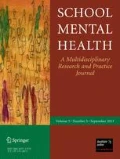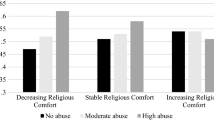Abstract
The ways in which youth cope with the following traumatic experiences have a critical impact on resilience and recovery, yet few measures adequately assess adolescent coping behaviors while exhibiting sound psychometric properties. The current study uses exploratory structural equation modeling (ESEM) to analyze data from the Kidcope, an assessment tool that is widely used in both clinical and research settings. A total of 652 hurricane-affected adolescent females completed the Kidcope approximately 6 months following Hurricane Katrina. ESEM results yielded a four-factor model including positive coping, blame and anger, wishful thinking, and social withdrawal. The coping behaviors represented in the four latent factors are consistent with results of a previous study of a hurricane-affected White, middle-class sample; however, they differ from the coping behaviors used by primarily Black, lower-income sample experiencing the same disaster. Results indicate that demographic and cultural characteristics may be strong influences in determining children’s coping styles and behaviors and should be taken into account when providing services to help youth recover.

Similar content being viewed by others
References
Alisic, E., Jongmans, M., Wesel, F., & Kleber, R. (2011). Building child trauma theory from longitudinal studies: A meta-analysis. Clinical Psychology Review, 31, 736–747.
Asparouhov, T., & Muthén, B. (2009). Exploratory structural equation modeling. Structural Equation Modeling, 16, 397–438.
Bollen, K. A. (1989). Structural equations with latent variables. New York, NY: Wiley.
Bowen, N. K., & Guo, S. (2012). Structural equation modeling. New York, NY: Oxford University Press.
Burby, R. J. (2006). Hurricane Katrina and the paradoxes of government disaster policy: Bringing about wise governmental decisions for hazardous areas. The Annals of the American Academy of Political and Social Science, 604(1), 171–191.
Cardeña, E., Dennis, J. M., Winkel, M., & Skitka, L. J. (2005). A snapshot of terror: Acute posttraumatic responses to the September 11 attack. Journal of Trauma & Dissociation, 6(2), 69–84.
Cheng, S. T., & Chan, A. C. (2003). Factorial structure of the Kidcope in Hong Kong adolescents. The Journal of Genetic Psychology, 164(3), 261–266.
Cheung, G. W., & Rensvold, R. B. (2002). Evaluating goodness-of-fit indexes for testing measurement invariance. Structural Equation Modeling, 9, 233–255. https://doi.org/10.1207/S15328007SEM0902_5.
Compas, B. E., Connor-Smith, J. K., Saltzman, H., Thomsen, A. H., & Wadsworth, M. E. (2001). Coping with stress during childhood and adolescence: Problems, progress, and potential in theory and research. Psychological Bulletin, 127(1), 87.
Cook, K. F., Kallen, M. A., & Amtmann, D. (2009). Having a fit: impact of number of items and distribution of data on traditional criteria for assessing IRT’s unidimensionality assumption. Quality of Life Research, 18(4), 447–460.
Federal Emergency Management Agency. (2015). St. Tammany Parish—Hurricane Katrina: A decade of progress through partnerships. Retrieved from https://www.fema.gov/media-library-data/1439929112610-2741ee543b024fdab8b3bef80b835f3c/FS_St_Tammany_Parish_Final_081215.pdf.
Folkman, S., & Lazarus, R. S. (1980). An analysis of coping in a middle-aged community sample. Journal of Health and Social Behavior, 21(3), 219–239.
Furr, J. M., Comer, J. S., Edmunds, J. M., & Kendall, P. C. (2010). Disasters and youth: A meta-analytic examination of posttraumatic stress, 78(6), 765–780.
Garcia, C. (2010). Conceptualization and measurement of coping during adolescence: A review of the literature. Journal of Nursing Scholarship, 42(2), 166–185.
Garrett, A. L., Grant, R., Madrid, P., Brito, A., Abramson, D., & Redlener, I. (2007). Children and megadisasters: Lessons learned in the new millennium. Advances in Pediatrics, 54(1), 189–214.
Gewirtz, A., Forgatch, M., & Wieling, E. (2008). Parenting practices as potential mechanisms for child adjustment following mass trauma. Journal of Marital and Family Therapy, 34(2), 177–192.
Guay, F., Morin, A. J., Litalien, D., Valois, P., & Vallerand, R. J. (2015). Application of exploratory structural equation modeling to evaluate the academic motivation scale. The Journal of Experimental Education, 83(1), 51–82.
Hampel, P., & Petermann, F. (2005). Age and gender effects on coping in children and adolescents. Journal of Youth and Adolescence, 34(2), 73–83.
Hanemann, W. M. (2008). What is the economic cost of climate change? (No. qt9g11z5 cc). Department of Agricultural and Resource Economics, UC Berkeley.
Hensley, L., & Varela, R. E. (2008). PTSD symptoms and somatic complaints following Hurricane Katrina: The roles of trait anxiety and anxiety sensitivity. Journal of Clinical Child & Adolescent Psychology, 37(3), 542–552.
Hu, L., & Bentler, P. M. (1999). Cutoff criteria for fit indexes in covariance structure analysis: Conventional criteria versus new alternatives. Structural Equation Modeling, 6, 1–55. https://doi.org/10.1080/10705519909540118.
Jöreskog, K. G. (2005). Structural equation modeling with ordinal variables using LISREL. Lincolnwood, IL: Scientific Software International Inc.
Kaniasty, K., & Norris, F. H. (2008). Longitudinal linkages between perceived social support and posttraumatic stress symptoms: Sequential roles of social causation and social selection. Journal of Traumatic Stress, 21(3), 274–281.
Kar, N. (2009). Psychological impact of disasters on children: Review of assessment and interventions. World Journal of Pediatrics, 5(1), 5–11.
Kar, N., & Bastia, B. K. (2006). Post-traumatic stress disorder, depression and generalised anxiety disorder in adolescents after a natural disaster: A study of comorbidity. Clinical Practice and Epidemiology in Mental Health, 2(1), 1.
King, L. A., King, D. W., Leskin, G. A., & Foy, D. W. (1995). The Los Angeles symptom checklist: A self-report measure of posttraumatic stress disorder. Assessment, 2, 1–17.
Kline, R. B. (2005). Principles and practice of structural equation modeling. New York, NY: Guilford Press.
La Greca, A. M., & Silverman, W. K. (2009). Treatment and prevention of posttraumatic stress reactions in children and adolescents exposed to disasters and terrorism: What is the e vidence? Child Development Perspectives, 3(1), 4–10.
Littleton, H., Horsley, S., John, S., & Nelson, D. V. (2007). Trauma coping strategies and psychological distress: A meta-analysis. Journal of Traumatic Stress, 20(6), 977–988.
Marsh, H. W., Morin, A. J., Parker, P. D., & Kaur, G. (2014). Exploratory structural equation modeling: An integration of the best features of exploratory and confirmatory factor analysis. Annual Review of Clinical Psychology, 10, 85–110.
Masten, A. S., & Narayan, A. J. (2012). Child development in the context of disaster, war, and terrorism: Pathways of risk and resilience. Annual Review of Psychology, 63, 227–257.
Masten, A. S., & Osofsky, J. D. (2010). Disasters and their impact on child development: Introduction to the special section. Child Development, 81(4), 1029–1039.
Morin, A. J., Arens, A. K., & Marsh, H. W. (2016). A bifactor exploratory structural equation modeling framework for the identification of distinct sources of construct-relevant psychometric multidimensionality. Structural Equation Modeling: A Multidisciplinary Journal, 23(1), 116–139.
Morrison, S. (2007). Symptoms of post-traumatic stress disorder in a sample of adolescent females following Hurricane Katrina: Coping as a moderator (Doctoral dissertation). Retrieved from ProQuest Dissertations and Theses.
Muthén, B. O. (2008). Exploratory structural equation modeling [PowerPoint slides]. Retrieved from http://www.statmodel.com/webtalks.shtml.
Muthén, L. K., & Muthén, B. O. (1998–2015). Mplus [computer software]. Los Angeles, CA: Muthén & Muthén.
National Commission on Children in Disasters. (2010). 2010 report to the President and Congress. AHRQ Publication No. 10-M037. Rockville, MD: Agency for Healthcare Research and Quality.
Osofsky, H. J., Osofsky, J. D., Kronenberg, M., Brennan, A., & Hansel, T. C. (2009). Posttraumatic stress symptoms in children after Hurricane Katrina: Predicting the need for mental health services. American Journal of Orthopsychiatry, 79(2), 212–220.
Paasivirta, M. E., Duarte, C. S., Wu, P., Bin, F., Goodman, R. F., Brown, E. J., et al. (2010). Factor structure of the Youth Coping in Traumatic Times (YCITT) scale. Psychiatry Research, 179(3), 357–362.
Perilla, J. L., Norris, F. H., & Lavizzo, E. A. (2002). Ethnicity, culture, and disaster response: Identifying and explaining ethnic differences in PTSD six months after Hurricane Andrew. Journal of Social and Clinical Psychology, 21(1), 20–45.
Pfefferbaum, B., Varma, V., Nitiéma, P., & Newman, E. (2014). Universal preventive interventions for children in the context of disasters and terrorism. Child and Adolescent Psychiatric Clinics of North America, 23(2), 363–382.
Pincus, D. B., & Friedman, A. G. (2004). Improving children’s coping with everyday stress: Transporting treatment interventions to the school setting. Clinical Child and Family Psychology Review, 7(4), 223–240.
Prati, G., & Pietrantoni, L. (2009). Optimism, social support and coping strategies as factors contributing to posttraumatic growth: A meta-analysis. Journal of Loss and Trauma, 14, 364–388.
Seiffge-Krenke, I., & Shulman, S. (1990). Coping style in adolescence: A cross-cultural study. Journal of Cross-Cultural Psychology, 21, 351–377. https://doi.org/10.1177/0022022190213006.
Skinner, E. A., Edge, K., Altman, J., & Sherwood, H. (2003). Searching for the structure of coping: A review and critique of category systems for classifying ways of coping. Psychological Bulletin, 129(2), 216–269.
Spirito, A. (1996). Commentary: Pitfalls in the use of brief screening measures of coping. Journal of Pediatric Psychology, 21(4), 573–575.
Spirito, A., Stark, L. J., Gil, K. M., & Tyc, V. L. (1995). Coping with everyday and disease-related stressors by chronically ill children and adolescents. Journal of the American Academy of Child and Adolescent Psychiatry, 34(3), 283–290.
Spirito, A., Stark, L. J., & Tyc, V. L. (1994). Stressors and coping strategies described during hospitalization by chronically ill children. Journal of Clinical Child Psychology, 23(3), 314–322.
Spirito, A., Stark, L. J., & Williams, C. (1988). Development of a brief coping checklist for use with pediatric populations. Journal of Pediatric Psychology, 13(4), 555–574.
Sveinbjornsdottir, S., & Thorsteinsson, E. B. (2008). Adolescent coping scales: A critical psychometric review. Scandinavian Journal of Psychology, 49(6), 533–548.
Tabachnick, B. G., & Fidell, L. S. (2013). Using multivariate statistics (6th ed.). Upper Saddle River, NJ: Pearson.
Vernberg, E. M., La Greca, A. M., Silverman, W. K., & Prinstein, M. J. (1996). Prediction of posttraumatic stress symptoms in children after Hurricane Andrew. Journal of Abnormal Psychology, 105(2), 237.
Vigna, J., Hernandez, B., Kelly, M., & Gresham, F. (2010). Coping behavior in hurricane- affected African American youth: Psychometric properties of the Kidcope. Journal of Black Psychology, 36(1), 98–121.
Weems, C. F., Taylor, L. K., Cannon, M. F., Marino, R. C., Romano, D. M., Scott, B. G., et al. (2010). Post traumatic stress, context, and the lingering effects of the Hurricane Katrina disaster among ethnic minority youth. Journal of Abnormal Child Psychology, 38(1), 49–56.
Yu, C. Y. (2002). Evaluating cutoff criteria of model fit indices for latent variable models with binary and continuous outcomes (Doctoral dissertation, University of California Los Angeles).
Author information
Authors and Affiliations
Corresponding authors
Ethics declarations
Conflict of interest
All authors declare that they have no conflict of interest.
Ethical Approval
All procedures performed in studies involving human participants were in accordance with the ethical standards of the institutional and/or national research committee and with the 1964 Helsinki declaration and its later amendments or comparable ethical standards. For this type of study (retrospective), formal consent is not required.
Rights and permissions
About this article
Cite this article
Powell, T.M., Wegmann, K.M. & Overstreet, S. Measuring Adolescent Coping Styles Following a Natural Disaster: An ESEM Analysis of the Kidcope. School Mental Health 11, 335–344 (2019). https://doi.org/10.1007/s12310-018-9288-x
Published:
Issue Date:
DOI: https://doi.org/10.1007/s12310-018-9288-x




